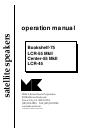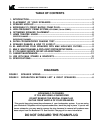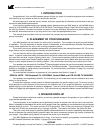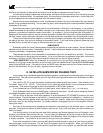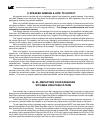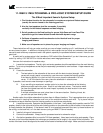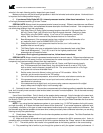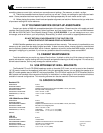
Bookshelf-75/Center-75/LCR-75/LCR-55
page 9
9. SPEAKER DAMAGE & HOW TO AVOID IT
An important factor to consider with any loudspeaker system is the potential for speaker damage. Even though
your M&K Speakers have extremely high power handling ability (especially for Main speakers), they still can be
damaged by relatively low powered amplifiers.
While very few M&K Speakers are actually returned for service, the vast majority of those returned are not for
manufacturing defects. Instead, they are returned because they have been overdriven, almost always because the
amplifier or receiver used was driven into clipping distortion. This damage is considered abuse, and is not
necessarily covered under warranty.
This clipping distortion occurs when the demands of the music are greater than the amplifier's available power.
It can occur at 20 watts with a small amplifier, or at 400 watts with a large amplifier. When this happens, the amplifier's
output waveform (which should look like a smooth arc) is "clipped" off, exhibiting a flat top instead of the arc.
This "clipped" waveform contains multiples of the original amplified frequencies, sometimes at higher levels than
the original signal itself. For tweeters, this can be very damaging, as this distortion is well above the audible range
(where you are unable to hear it), and where the tweeter is most vulnerable to damage.
When an amplifier "clips", it generates a high level of high frequency energy (much higher than normal program
material) which passes through the crossover to the tweeter. This energy can overheat the tweeter in a matter of
seconds and destroy it.
When this happens, the sound becomes harsh and grating, and a break-up is often audible in the bass
frequencies. It will become uncomfortable to listen to, especially when compared to a slightly lower volume level.
When you are listening at high volume levels, be aware of the onset of clipping distortion, and turn the volume down
slightly if the sound takes on the character described above.
When tone controls or equalizers are used to boost frequencies, the problem occurs much more rapidly. Even
a small boost of low or high frequencies can easily double the power requirement and lead to amplifier clipping at
moderate levels. Therefore, you should use your tone controls judiciously, avoiding extreme boosts of the bass and
treble controls, especially when you are listening at high volume levels.
The best way to avoid speaker damage is to use common sense. Use moderate boosts of tone controls or
equalizers, at the very most. Listen carefully for any harshness and break-up, especially at high volume levels, and
turn down the volume when needed. If you cannot get enough volume, you may need to consider a higher-powered
amplifier. If you have any questions about this, please contact M&K, and we will be happy to discuss it with you further.
10. BI- AMPLIFYING YOUR SPEAKERS
WITH M&K HIGH PASS FILTERS
One excellent way to improve the sound of your Main speakers (and protect them if you listen at high volume
levels to music with substantial deep bass output), is by using an M&K High-Pass Filter. M&K's HP-80 and VF-80 High-
Pass Filters improve the performance of any system that allows for separation of its preamp and power amp stages,
by filtering the bass signal fed to the main amplifier and Main speakers.
These filters will give you greater dynamic range, lower distortion, and an increased maximum output level. If
you have any questions about the suitability of your components, please contact your M&K dealer or the factory.
To use these filters with an integrated amp or receiver, the amp/receiver MUST have back panel RCA jacks
labelled Preamp/Main Output AND Power Amp/Main Input (or Front Out/Front In) for all of the channels you want to
filter (including the center channel). You may have to operate a switch or remove jumper connections on the amplifier.
If you can use one of these filters, you simply connect one set of shielded RCA - RCA interconnect cables between
the receiver, amp or preamp's Main Output and the HP-80 or VF-80, with a second set between the HP-80 or VF-80
and the Main Input of the receiver or amplifier, and a third set from the HP-80 or VF-80 to the Subwoofer. See the
instruction sheet that comes with the High-Pass Filter for more information.
Bookshelf-75/LCR-55MkII/Center-55MkII/LCR-45



